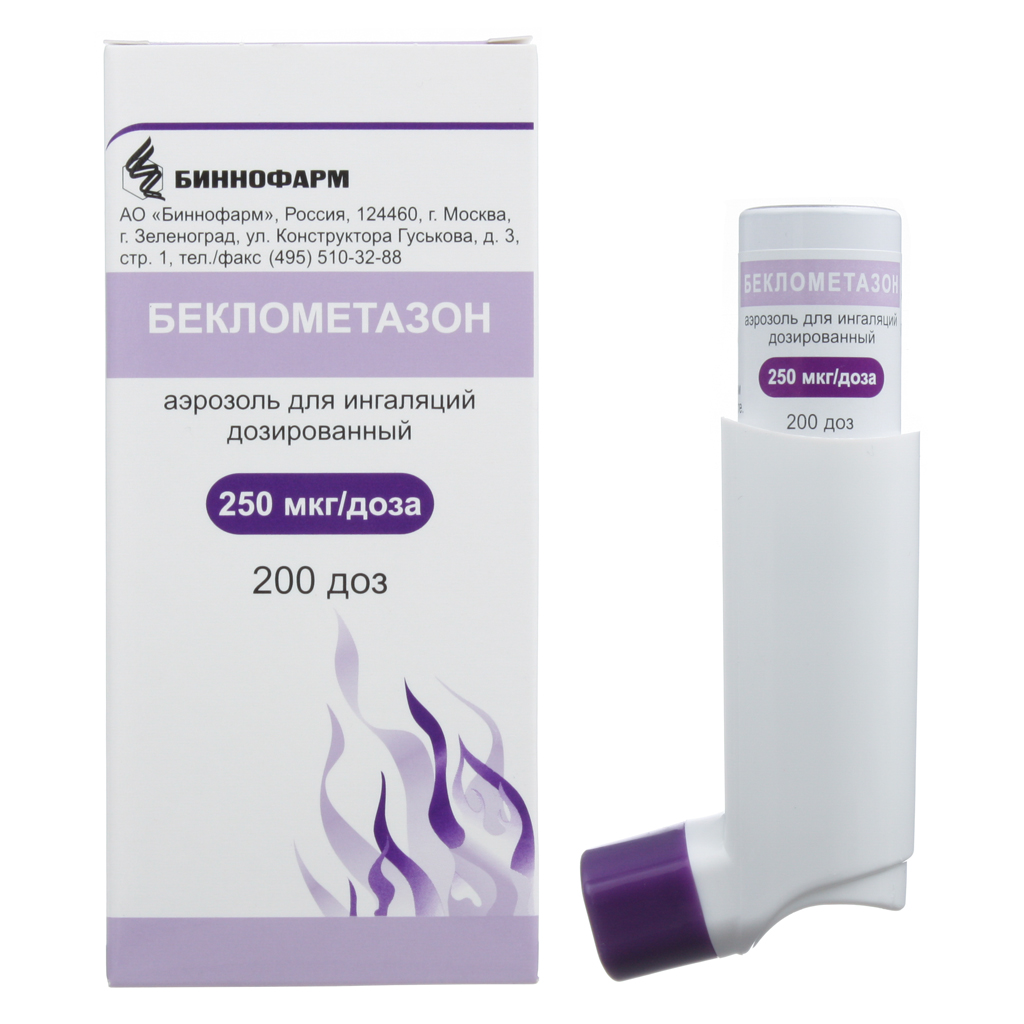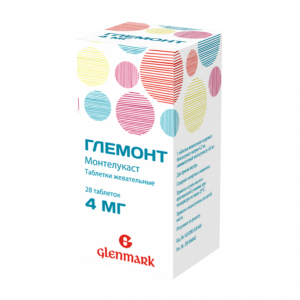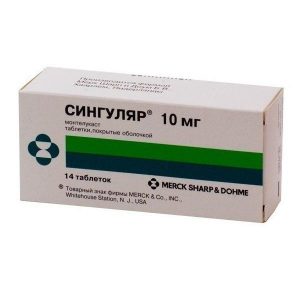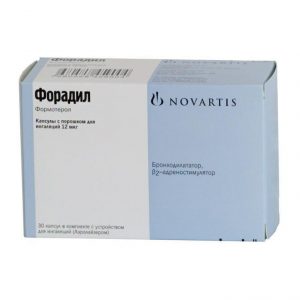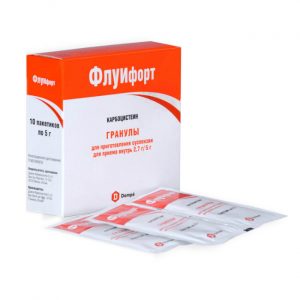Description
Release form
Inhalation aerosol dosage 50 mcg / dose, 100 mcg / dose or 250 mcg / dose.
200 doses per cylinder of aluminum with a protective coating, sealed by a metering valve and equipped with a spray nozzle with a protective cap. Each cylinder, together with a nozzle-sprayer and a protective cap, as well as instructions for use, is placed in a pack.
Indications
Basic therapy for various forms of bronchial asthma in adults and children over 4 years of age.
Contraindications
Hypersensitivity to any component of the drug.
pulmonary tuberculosis.
Children’s age up to 4 years. Beclomethasone, containing 250 mcg in 1 dose, is not intended for use in pediatrics (i.e. in children under 18 years of age).
Caution
Use for glaucoma, systemic infections (bacterial, viral, fungal, parasitic), osteoporosis, cirrhosis, hypothyroidism, pregnancy, lactation.
Special instructions
Before prescribing inhalation preparations, it is necessary to instruct the patient on the rules for their use, which ensure that the medicine reaches the fullest parts of the lungs. The development of oral candidiasis is most likely in patients with a high level of precipitating antibodies in the blood against Candida fungus, which indicates a previous fungal infection. After inhalation, rinse your mouth and throat with water. For the treatment of candidiasis, topical antifungal drugs can be used while continuing with beclomethasone therapy.
If patients take corticosteroids by mouth, then beclomethasone is prescribed while taking the same dose of corticosteroids, while patients should be in relatively stable condition. After about 1-2 weeks, the daily dose of oral GCS begins to gradually decrease. The dose reduction regimen depends on the duration of previous therapy and on the magnitude of the initial dose of corticosteroids. Regular use of inhaled corticosteroids allows in most cases to cancel oral corticosteroids (patients who need to take no more than 15 mg of prednisone can be completely transferred to inhalation therapy). Moreover, in the first months after the transition, the patient’s condition should be carefully monitored until his pituitary-adrenal system is restored enough to provide an adequate response to stressful situations (for example, trauma, surgery or infection).
When transferring patients from taking systemic corticosteroids to inhalation therapy, allergic reactions (for example, allergic rhinitis, eczema) that were previously suppressed by systemic drugs may occur.
Patients with reduced function of the adrenal cortex, transferred to inhalation treatment, must have a reserve of corticosteroids and always carry a warning card, which should indicate that in stressful situations they need additional systemic prescription of corticosteroids (after eliminating the stressful situation, the dose of corticosteroids lower again). A sudden and progressive worsening of asthma symptoms is a potentially dangerous condition that often threatens the patient ² ¢s life and requires an increase in the dose of corticosteroids. An indirect indicator of treatment failure is a more frequent than before, the use of 0-2 short-acting adrenostimulants.
beclomethasone dipropionate for inhalation is not intended to stop attacks, but for regular daily use. For the relief of attacks, 3-2 short-acting adrenostimulants (for example, salbutamol) are used. In case of severe exacerbation of bronchial asthma or insufficient therapy, the dose of inhaled beclomethasone dipropionate should be increased and, if necessary, a systemic corticosteroids and antibiotic should be prescribed if infection develops.
paradoxical bronchospasm should immediately stop the use of beclomethasone, assess the condition of the patient, conduct an examination and, if necessary, prescribe therapy for other drugs with prolonged use of any inhaled GCS, especially in high doses, systemic effects may be noted (see “Side Effects”), but the likelihood of their development is significantly lower than when taking GCS inside. Therefore, it is especially important that when the therapeutic effect is achieved, the dose of inhaled GCS should be reduced to the minimum effective dose that controls the course of the disease. At a dose of 1,500 mcg / day, the drug in most patients does not significantly suppress adrenal function. In connection with the possible adrenal insufficiency, special care should be taken and regular monitoring of the adrenal cortex function indicators when transferring patients taking corticosteroids inward to beclomethasone treatment.
It is recommended to regularly monitor the growth dynamics of children receiving inhaled GCS for a long time.
Introduction can be carried out with the help of special dispensers (spacers) that improve the distribution of the drug in the lungs and reduce the risk of side effects.
Abrupt withdrawal of beclomethasone aerosol is not recommended.
It is necessary to protect the eyes from getting the drug. By washing after inhalation, it is possible to prevent damage to the skin of the eyelids and nose.
A can of Beclomethasone must not be punctured, disassembled, or thrown into the fire, even if it is empty. Like most other aerosol inhalation products, beclomethasone may be less effective at low temperatures. When cooling the cylinder, it is recommended to remove the inhaler nozzle from it and warm it with your hands for several minutes.
Effect on ability to drive vehicles and mechanisms
No data.
Composition
1 dose of the preparation contains:
Active ingredient:
beclomethasone dipropionate – 0.25 mg (in terms of 100% substance)
Excipients:
ethanol 96% 10.5 mg,
norflurane (tetrafluoroethane) 74.4 mg.
Each inhaler contains 200 doses.
Dosage and Administration
beclomethasone is for inhalation use only.
beclomethasone is used regularly (even in the absence of disease symptoms), the dose of beclomethasone dipropionate is selected taking into account the clinical effect in each case.
In mild cases of bronchial asthma, forced inspiratory volume (FEV) or peak expiratory flow rate (PSV) is more than 80% of the expected values ² ¹ ² ¹with a spread in PSV of less than 20%.
In the moderate course of FEV or PSV is 60-80% of the proper values, daily variation in PSV indicators is 20-30%.
In severe course of FEV or PSV is 60% of the proper values, the daily spread of PSV indicators is more than 30%.
When switching to a high dose of inhaled beclomethasone dipropionate, many patients receiving systemic glucocorticosteroids will be able to reduce their dose, cancel them altogether.
The initial dose of beclomethasone is determined by the severity of bronchial asthma. The daily dose is divided into several doses.
Depending on the individual response of the patient, the dose of the drug can be increased until the clinical effect or reduced to the minimum effective dose.
Children 4 to 12 years old
The initial dose is 50 mcg 2 times a day. If necessary, the initial dose can be increased to 100 mcg 2 times a day. The maximum single dose is 200 mcg.
The maximum daily dose is 400 mcg. The daily dose is divided into 2-4 doses.
Adults and children 12 years of age and older:
Recommended starting doses:
mild bronchial asthma – 200-600 mcg / day
moderate bronchial asthma – 600-1000 mcg / day
severe bronchial asthma – 1000-2000 mcg / day.
Treatment of bronchial asthma is based on a stepwise approach – therapy is started according to the stage corresponding to the severity of the disease. Inhaled corticosteroids are prescribed in the second stage of therapy.
Step 2. Basic therapy.
beclomethasone dipropionate 100-400 mcg 2 times a day.
Step 3. Basic therapy.
Use inhaled GCS in a high dose or in a standard dose, but in combination with long-acting inhaled p-2-adrenergic agonists.
Beclomethasone dipropionate in a high dose – 800-1600 mcg / day, in some cases megadoses up to 2000 mcg / day.
Step 4. Severe asthma.
Beclomethasone dipropionate in a high dose – 800-1600 mcg / day, in some cases megadoses up to 2000 mcg / day.
Step 5. Severe asthma.
Beclomethasone dipropionate in high dose (see steps 3 and 4).
Special patient groups
There is no need to adjust the dose of beclomethasone in the elderly, in patients with renal or hepatic insufficiency.
Skipping one dose of
If you accidentally skip inhalation, take the next dose at the right time in accordance with the treatment regimen.
Instructions for the patient on the use of the
inhaler Check the operation of the inhaler before using it for the first time, as well as if you have not used it for some time, or if the cylinder has been cooled to a low temperature, and then you have warmed it to room temperature. To check, remove the protective cap from the inhaler nozzle, turn the bottle upside down, put your index finger on the bottom of the bottle, and thumb – to the top of the inhaler nozzle, shake the can up and down and make 2 clicks with the thumb and forefinger, pointing the outlet of the inhaler nozzle to the side. After the aerosol spray appears after the second press, proceed as described below, starting with the words: ² ÑMake sure that there is no dust and dirt in the outlet pipe ² Ñ.
With regular use of the drug, proceed as follows:
Remove the protective cap from the inhaler nozzle. Make sure there is no dust or dirt in the outlet pipe.
Hold the bottle upright with the bottom up, with your index finger on the bottom of the bottle and the thumb on top of the inhaler nozzle. Shake the can up and down.
Exhale as deep as possible (no tension). Use your lips to gently hold the outlet tube of the inhaler nozzle.
Take a slow deep breath. At the time of inspiration, by pressing the thumb and forefinger, release a dose of the drug. Keep breathing in slowly.
Remove the inhaler nozzle from your mouth and hold your breath for 10 seconds or as much as you can without stress. Exhale slowly.
If more than one dose of medication is required, wait about a minute and then repeat the procedure from step 2. Replace the protective cap on the inhaler nozzle.
Do not rush during steps 3 and 4. It is important to take a breath as slowly as possible when a dose of medicine is issued. Practice in front of the mirror first. If you notice steam escaping from the corners of your mouth, start again from step 2.
Cleaning the inhaler.
The inhaler nozzle should be cleaned at least once a week. Remove the inhaler nozzle from the bottle and rinse it and the protective cap with warm water. Do not use hot water. Dry thoroughly, but do not use heating devices for this. Put the protective cap back on the inhaler nozzle and the cap on the cylinder. Do not immerse the cylinder in water.
Side effects
Adverse reactions are listed based on the anatomical and physiological classification and occurrence.
Infections: very often – candidiasis of the mouth and pharynx. Using a spacer and rinsing the mouth and throat with water after inhalation reduces the likelihood of these side effects.
From the immune system: infrequently – skin hypersensitivity reactions, including rash, urticaria, itching, redness and swelling of the eyes, face, lips and mucous membrane of the mouth and pharynx are very rare – angioedema, anaphylactic reactions.
From the endocrine system: possible systemic effects: very rarely – inhibition of adrenal cortex function, stunted growth in children and adolescents, cataracts, glaucoma.
From the respiratory system: often dysphonia (hoarseness of the voice) or irritation of the mucous membrane of the pharynx, very rarely – paradoxical bronchospasm, which must be immediately stopped with a short-acting inhalation [3-2-adrenostimulator. In the event of a paradoxical bronchospasm, it is necessary to immediately stop the use of the drug in inhalations, evaluate the patient’s condition, conduct the necessary examination and prescribe the necessary treatment.
From the skin and subcutaneous fat: often – bruising, thinning of the skin.
Drug Interactions
Beclomethasone restores the patient’s response to beta-adrenergic agonists, reducing the frequency of their use.
When combined with microsomal oxidation inducers (including phenobarbital, phenytoin, rifampicin, etc.), beclomethasone may be less effective.
With simultaneous use with methandienone, estrogens, beta2-adrenergic agonists, theophylline, as well as systemic corticosteroids, beclomethasone increases the effectiveness.
With the simultaneous use of beclomethasone enhances the effect of beta-adrenergic agonists.
Overdose
Symptoms: An acute overdose of the drug can lead to a temporary decrease in the function of the adrenal cortex, which does not require emergency therapy, since the function of the adrenal cortex is restored within a few days, which is confirmed by the concentration of cortisol in the plasma. In chronic overdose, persistent suppression of adrenal cortex function may be observed.
Treatment: In such cases, it is recommended to monitor the reserve function of the adrenal cortex. In case of an overdose, beclomethasone treatment with dipropionate can be continued in doses sufficient to maintain a therapeutic effect.
Storage conditions
Store at a temperature not exceeding 25 ° C.
Keep away from heating system and direct sunlight.
Keep out of the reach of children!
Protect from falls and bumps.
Expiration
3 years. Do not use after the expiry date.
Deystvuyuschee substances
beclomethasone
Conditions of supply of pharmacies
prescription
Medicinal form
aÑrozoly dlya ingalyatsiy
Appointment
Children prescribing, Adult prescription
Indications
All rgichesky rhinitis, bronchial asthma, chronic obstructive pulmonary disease
